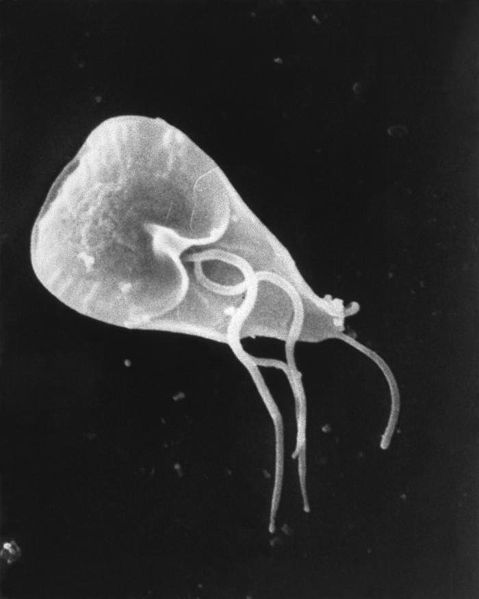Giardiasis: Difference between revisions
Jump to navigation
Jump to search
m (Robot: Automated text replacement (-{{SIB}} + & -{{EH}} + & -{{EJ}} + & -{{Editor Help}} + & -{{Editor Join}} +)) |
Rim Halaby (talk | contribs) No edit summary |
||
| Line 1: | Line 1: | ||
__NOTOC__ | |||
'''For the WikiPatient page for this topic, click [[Giardiasis (patient information)|here]]''' | |||
{{Infobox_Disease | {{Infobox_Disease | ||
| Name = {{PAGENAME}} | | Name = {{PAGENAME}} | ||
| Line 13: | Line 15: | ||
| MeshID = D005873 | | MeshID = D005873 | ||
}} | }} | ||
''' | {{Giardiasis}} | ||
{{CMG}}; '''Associate Editor-In-Chief:''' {{CZ}} | |||
{{SK}} ARF; acute kidney failure; kidney failure, acute; renal failure, acute; uremia, acute; acute tubular necrosis | |||
==[[Giardiasis overview|Overview]]== | |||
==[[Giardiasis historical perspective|Historical Perspective]]== | |||
==[[Giardiasis pathophysiology|Pathophysiology]]== | |||
==[[Giardiasis causes|Causes]]== | |||
==[[Giardiasis differential diagnosis|Differentiating Giardiasis from other Diseases]]== | |||
==[[Giardiasis epidemiology and demographics|Epidemiology and Demographics]]== | |||
==[[Giardiasis risk factors|Risk Factors]]== | |||
==[[Giardiasis screening|Screening]]== | |||
== | ==[[Giardiasis natural history, complications and prognosis|Natural History, Complications and Prognosis]]== | ||
== | ==Diagnosis== | ||
[[Giardiasis history and symptoms|History and Symptoms]] | [[Giardiasis physical examination|Physical Examination]] | [[Giardiasis laboratory findings|Laboratory Findings]] | [[Giardiasis other diagnostic studies|Other Diagnostic Studies]] | |||
==Treatment== | ==Treatment== | ||
[[Giardiasis medical therapy|Medical Therapy]] | [[Giardiasis primary prevention|Primary Prevention]] | [[Giardiasis secondary prevention|Secondary Prevention]] | [[Giardiasis cost-effectiveness of therapy|Cost-Effectiveness of Therapy]] | [[Giardiasis future or investigational therapies|Future or Investigational Therapies]] | |||
== | ==Case Studies== | ||
[[Giardiasis case study one|Case #1]] | |||
==External links== | ==External links== | ||
*[http://www.cdc.gov/ncidod/dpd/parasites/giardiasis/factsht_giardia.htm Giardiasis Fact Sheet] | *[http://www.cdc.gov/ncidod/dpd/parasites/giardiasis/factsht_giardia.htm Giardiasis Fact Sheet] | ||
{{Protozoal diseases}} | {{Protozoal diseases}} | ||
Revision as of 17:40, 4 October 2012
For the WikiPatient page for this topic, click here
| Giardiasis | |
 | |
|---|---|
| Giardia cell, SEM | |
| ICD-10 | A07.1 |
| ICD-9 | 007.1 |
| DiseasesDB | 5213 |
| MedlinePlus | 000288 |
| eMedicine | emerg/215 |
| MeSH | D005873 |
|
Giardiasis Microchapters |
|
Diagnosis |
|---|
|
Treatment |
|
Case Studies |
|
Giardiasis On the Web |
|
American Roentgen Ray Society Images of Giardiasis |
Editor-In-Chief: C. Michael Gibson, M.S., M.D. [1]; Associate Editor-In-Chief: Cafer Zorkun, M.D., Ph.D. [2]
Synonyms and keywords: ARF; acute kidney failure; kidney failure, acute; renal failure, acute; uremia, acute; acute tubular necrosis
Overview
Historical Perspective
Pathophysiology
Causes
Differentiating Giardiasis from other Diseases
Epidemiology and Demographics
Risk Factors
Screening
Natural History, Complications and Prognosis
Diagnosis
History and Symptoms | Physical Examination | Laboratory Findings | Other Diagnostic Studies
Treatment
Medical Therapy | Primary Prevention | Secondary Prevention | Cost-Effectiveness of Therapy | Future or Investigational Therapies
Case Studies
External links